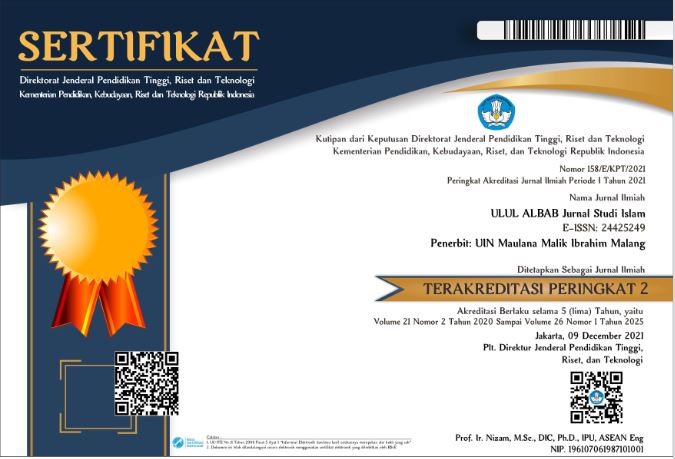‘FITNA’ IN EVERYDAY LIFE: Phenomena of the Digital Behavior of Indonesian Muslim Society on Dajjal Hadith
Abstract
Dajjal appearance discussion in the last decade has been the trending among Muslim. There are massive search for religious doctrines text on Dajjal in digital media. This is oriented towards certain views about the world, social and cultural conditions, political project, political subjectivity, attitudes, and practice or competence. The behavior affects social-political life through the contextualization of hadith about Dajjal. This study aims to obtain a complete picture of digital media behavior in understanding religious doctrines related to Fitna of Dajjal among Muslims. This article combines Muslim theory of Cosmopolitanism Khairuddin Aljunied and living hadith approach, supported by data from google trend search throughout 2019. The results showed that there were four digital behaviors of Indonesian Muslim related to Dajjal hadith, first, searching instantaneously; second, reviewing from internet; third, joining the contextualisation discussion; and fourth, liking the personalization and illustration. The most frequently sought topic is about the prayer to be protected from Fitna of Dajjal. In addition, the study also tried to prove that this digital behavior is formed massively because of supply and demand pattern. It means that there are groups producing Dajjal hadith in public sphere regularly since they are supported by the many interests of consumers.
Keywords
Full Text:
PDFReferences
Afwadzi, Benny. 2016. “Membangun Integrasi Ilmu-Ilmu Sosial Dan Hadis Nabi.” Jurnal Living Hadis 1(1): 101–27. DOI: https://doi.org/10.14421/livinghadis.2016.1070
Aji, Rustam. 2016. “Digitalisasi, Era Tantangan Media (Analisis Kritis Kesiapan Fakultas Dakwah Dan Komunikasi Menyongsong Era Digital).” Islamic Communication Journal 1(1): 43–54. DOI: http://dx.doi.org/10.21580/icj.2016.1.1.1245
Ali, Hasanuddin, and Lilik Purwadi. 2016. Indonesia 2020: The Urban Middle Class Millenials. Jakarta: Alvara Research Center.
AlJunied, Khairuddin. 2016. Muslim Cosmopolitanism Southeast Asian Islam in Comparative Perspective. Edinburg: Edinburg University Press.
Annazilli, Haqqi. 2018. “Relasi Antara Agama Dan Media Baru.” Jurnal Ilmiah Syi’ar 18(2): 26–44. DOI: http://dx.doi.org/10.29300/syr.v18i2.1677
Armita, Pipin, and Jani Arni. 2017. “Dinamika Pemahaman Ulama Tentang Hadis Dajjal (Dari Interpretasi Tekstual Ke Interpretasi Kontekstual).” Jurnal Ushuluddin 25(2): 208–20. DOI: http://dx.doi.org/10.24014/jush.v25i2.2398
Campbell, Heidi A. 2010. When Religion Meets New Media. London and New York: Rouledge.
Campbell, Heidi A. 2012. Digital Religion: Understanding Religious Practice in New Media Worlds. London and New York: Rouledge.
Dahlan, Alwi. 2012. “Understanding the New Media.” Suara Merdeka.
Deal, Jennifer J., David G. Altman, and Steven G. Rogelberg. 2010. “Millennials at Work: What We Know and What We Need to Do (If Anything).” Journal of Business and Psychology 25(2): 191–99. DOI: https://doi.org/10.1007/s10869-010-9177-2
Eller, Jack David. 2014. Introducing Anthropology of Religion. London and New York: Rouledge.
Fatkhullah, Faiz Karim, Tajudin Nur, and Undang Ahmad Darsa. 2018. “The Reception of Dajal Story in The Saifu Ad-Dharib.” Humanus 17(1): 37–52. DOI: https://doi.org/10.24036/humanus.v17i1.8779
Fisher, Humphrey J., and Virginia Rowland. 1971. “Firearms in the Central Sudan.” The Journal of African History 12(2): 215–39. DOI: https://doi.org/10.1017/S0021853700010641
Hidayaturrahman, Mohammad, and D.I. Ansusa Putra. 2019. “The Role of Technology and Social Media in Spreading the Qur’an and Hadiths by Mubalig.” Dinika: Academic Journal of Islamic Studies 4(1): 45–64. DOI: 10.22515/dinika.v4i1.1858
Imron, Ali. 2019. “The Millenial Generation, Hadith Memes, and Identity Politics: The New Face of Political Contestation in Contemporary Indonesia.” Ulul Albab: Jurnal Studi Islam 20(2): 255–83. DOI: http://dx.doi.org/10.18860/ua.v20i2.5675
Jinan, Mutohharun. 2012. “New Media Dan Pergeseran Otoritas Keagamaan Islam Di Indonesia.” Jurnal Lektur Keagamaan 10(1): 181–208. DOI: http://dx.doi.org/10.31291/jlk.v10i1.178
Kementerian Pendidikan dan Budaya. 2016. Kamus Besar Bahasa Indonesia (KBBI).
Khan, Muhammad Muhsin. 1985. Sahîh Al-Bukhârî (Summarize). Darussalam.
Kurniawan, Fachrul. 2012. “Pemanfaatan Langsung Teknologi Informasi Dalam Dakwah Islam.” Ulul Albab: Jurnal Studi Islam 13(1): 65–76. DOI: http://dx.doi.org/10.18860/ua.v0i0.2379
Lifintseva, Tatyana P., Leonid M. Isaev, and Alisa R. Shishkina. 2015. “Fitnah: The Afterlife of a Religious Term in Recent Political Protest.” Religions 6(2): 527–42. DOI: https://doi.org/10.3390/rel6020527
McClure, Paul K. 2017. “Tinkering with Technology and Religion in the Digital Age: The Effects of Internet Use on Religious Belief, Behavior, and Belonging.” Journal for the Scientific Study of Religion 56(3): 481–97. DOI: https://doi.org/10.1111/jssr.12365
Muslim, Imam. 2010. Shahih Muslim. Beirut: Dâr al-Fikr.
Ningtyas, Ika. 2019. “[Fakta Atau Hoaks] Benarkah Ada Kemarau Panjang Dalam 3 Tahun Dan Menjadi Tanda-Tanda Kedatangan Dajjal?” https://cekfakta.tempo.co/fakta/361/fakta-atau-hoaks-benarkah-ada-kemarau-panjang-dalam-3-tahun-dan-menjadi-tanda-tanda-kedatangan-dajjal (January 5, 2020).
Pals, Daniel L. 2019. Eight Theories of Religion. Oxford: Oxford University Press.
Pojoksatu. 2019. “Masjid Al Safar Disebut Simbol Dajjal, Ridwan Kamil: Merusak Nama Baik Dan Keimanan Saya.” https://pojoksatu.id/news/berita-nasional/2019/06/01/masjid-al-safar-disebut-simbol-dajjal-ridwan-kamil-merusak-nama-baik-dan-keimanan-saya/ (January 5, 2020).
Poll, Gallup. 2016. “Religion Dominates Daily Life in the Islamic World.” https://news.gallup.com/poll/5383/religion-dominates-daily-life-islamic-world.aspx (January 5, 2020).
Purwaningsih, Sri. 2017. “Kritik Terhadap Rekonstruksi Metode Pemahaman Hadis Muhammad Al-Ghazali.” Jurnal Theologia 28(1): 75–102. DOI: http://dx.doi.org/10.21580/teo.2017.28.1.1189
Putra, D.I. Ansusa, and Agus Firdaus Chandra. 2019. “Mediatization of Islamic Doctrine in A New Era of Digital Indonesia: The Case of Hadits on Dajjal.” Jurnal Theologia 30(2). DOI: http://dx.doi.org/10.21580/teo.2019.30.2.4327
Qudsy, Saifuddin Zuhri. 2016. “Living Hadis: Genealogi, Teori, Dan Aplikasi.” Jurnal Living Hadis 1(1): 177–96. DOI: https://doi.org/10.14421/livinghadis.2016.1073
Saritoprak, Zeki. 2003. “The Legend of Al-Dajjāl (Antichrist): The Personification of Evil in the Islamic Tradition.” Muslim World 93(2): 291–307. DOI: https://doi.org/10.1111/1478-1913.00024
Supriyadi, Mohammad. 2015. “Politisasi Agama Di Ruang Publik: Komunikasi SARA Dalam Perdebatan Rational Choice Theory.” Jurnal Keamanan Nasional 1(2): 387–428. DOI: https://doi.org/10.31599/jkn.v1i3.32
Suryadilaga, Muhammad Alfatih. 2014. “Kajian Hadis Di Era Global.” Esensia: Jurnal Ilmu-Ilmu Ushuluddin 15(2): 199–212. DOI: https://doi.org/10.14421/esensia.v15i2.773
DOI: https://doi.org/10.18860/ua.v21i1.7750
Refbacks
- There are currently no refbacks.
Tools:




Indexed By:








All publication by Ulul Albab: Jurnal Studi Islam are licensed under a Creative Commons Attribution-ShareAlike (CC BY-SA)
Ulul Albab: Jurnal Studi Islam, P-ISSN : 1858-4349, E-ISSN : 2442-5249



